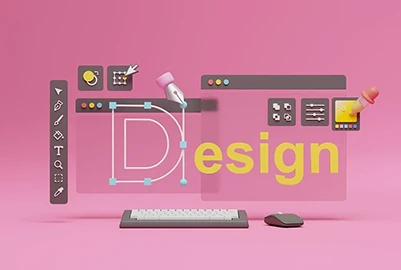Interested in enhancing your design skills with graphic design programs? Find the best options to take your expertise to the next level in this guide.
The demand for skilled graphic designers is booming across various industries, making it essential to choose the right program to kickstart or elevate your career in this exciting field. Whether you’re just starting out or are a seasoned professional looking to upskill, graphic design programs offer the appropriate guidance to help you meet your goals.
But with so many options available—from bootcamps and certificate courses to full degree programs—how do you know which one is the best fit for you? Navigating the vast online learning landscape can be overwhelming, but don’t worry! In this article, we’ve curated a list of the top 12 graphic design programs for 2025, providing key details on duration, pricing, and learning formats. By the end, you’ll have all the information you need to make an informed decision and choose the right path to help you achieve your design aspirations.
Here’s everything we’ll be covering in this article!
- Important parameters to consider while applying for a graphic design program
- 12 graphic design programs to consider
- Conclusion & next steps
Important parameters to consider while applying for a graphic design program

Image Courtesy: Best Degree Programs
When applying for a graphic design program, you must evaluate several factors to ensure the program aligns with your career aspirations, future goals, and learning preferences. Here are some essential considerations to make:
1. Admission requirements
Some graphic design programs accept students from any background, while others may look for a design background or a portfolio for admission. Understand the specific expectations and assess whether you meet the requirements. Also, check if you need to go through an entrance exam.
2. Accreditation
Ensure the institution is accredited by a recognized body, indicating a high standard of education. Accreditation enhances the value of your degree and ensures the curriculum meets industry standards. For international aspirations, choose programs with global recognition and opportunities to work with international clients.
3. Course details and duration
Understand the course details to assess the workload and commitments involved. Some programs are short-term, focusing on niche skills, while others are certificate courses or full degree-level programs that last 3 to 4 years. What you choose will depend on your career goals and the time you have available.

4. Curriculum and specializations
Review the course content for a balance between foundational design principles and advanced topics like UI UX design, motion graphics, or branding. Look for programs offering electives or specializations that suit your interests.
Additionally, focus on programs that offer portfolio development, as a strong portfolio is important when applying for roles. To understand the kind of work you should add to your portfolio, we recommend checking out AND Academy learner Kayo Hattori’s graphic design project on creatives for social media
5. Fee and scholarships
Consider the cost of the program, including tuition, software subscriptions, and materials. Research available scholarships, grants, and financial aid options that you can opt for.
6. Faculty expertise and networking
Research the qualifications and industry experience of the faculty members. Their portfolios and strong connections to the industry can provide valuable mentorship and networking opportunities.
7. Location
Institutions in design hubs or cities with a thriving creative industry may provide more exposure and internship opportunities.
8. Internship and placement opportunities
Check if the program offers internships or collaborations with design firms. Research alumni placement records and the program’s ties with the design industry.
12 Graphic Design programs to consider

Image Courtesy: Dice
1. AND Academy
AND Academy is a design upskilling platform that provides professional design courses for aspirants from any background. The Graphic Design Certificate, offered by AND Academy, is a fast-track course for working professionals looking to learn the concepts and fundamental principles of the field and apply them to their print and digital media designs. The course is structured into three main components: Fundamentals of Visual Design, Design for Publication, and Design for Digital. Each major module ends with a hands-on project during which students are expected to apply the theory they have learned. These projects can then be used as part of a professional graphic design portfolio, ensuring learners are ready for job applications and interviews.
Pros:
- Ideal for working professionals seeking to upskill in a short span
- Live, instructor-led sessions, cohort-based learning, and full integration with the latest design tools
- Portfolio-building through real-world project development
- Online mode of learning makes it accessible across geographical boundaries
Cons:
- The extensive curriculum is unlike most online learning platforms and requires ample time commitment
- The fast-paced structure may not be ideal for all learners
Duration
18 weeks, 100 hours of live lessons
Format
Online
Fees
Available upon inquiry
Please visit the course page link for more information
2. Rhode Island School of Design, Rhode Island
The Rhode Island School of Design (RISD) offers a highly acclaimed Bachelor of Fine Arts (BFA) degree in graphic design. Renowned as one of the best art and design institutions, RISD provides a comprehensive curriculum that combines creativity with technical proficiency and critical thinking skills. Students begin their journey at RISD without declaring a major, which allows them to explore various disciplines before choosing graphic design midway through their first year. Choosing this graphic design education means investing in a program that offers excellence, innovation, and a strong foundation for your future career. With its accomplished faculty and premium facilities, RISD provides an environment where aspiring graphic designers can thrive and reach their full potential.
Pros:
- Expert faculty and resources
- Flexible start without declaring a major
- A collaborative environment for networking
Cons:
- Competitive admission
Duration
4 years
Format
Offline
Fees
Approximately $61,268, excluding additional costs
Please visit the course page link for more information
3. The Pratt Institute, New York
The Pratt Institute, situated in Brooklyn, New York, offers a prestigious Bachelor of Fine Arts (BFA) in communications design. This interdisciplinary program allows students to specialize in one of three areas: advertising, illustration, or graphic design. Many faculty members are active professionals who bring real-world experience to their part-time teaching roles. Alumni praise the program for its innovative approach and for effectively preparing them for careers in their respective fields.
Pros:
- Faculty active in the industry provide valuable networking opportunities and current industry insights
- Proximity to a wide range of art and design resources
Cons:
- Cost of living in New York
- Part-time faculty members may have limited availability outside of class hours
- Competitive environment
Duration
4 years
Format
Offline
Fees
Approximately $59,550, excluding additional costs
Please visit the course page link for more information

4. ArtCenter College of Design, California
The ArtCenter College of Design offers a Bachelor of Fine Arts (BFA) in graphic design that provides extensive training in both traditional and contemporary media. The program aims to develop well-rounded practitioners with skills spanning all areas of graphic design. Emphasizing an experimental and socially conscious approach, the curriculum encourages students to push creative boundaries while considering the societal impact of their work. Graduates benefit from strong career prospects, often securing positions in diverse industries and earning higher salaries than their peers.
Pros:
- Collaboration with subject experts
- Opportunity to develop a personal brand
- Robust visual and cultural literacy
Cons:
- Highly selective
- Intensive workload
Duration
Available upon inquiry
Format
Offline
Fees
Available upon inquiry
Please visit the course page link for more information
5. Yale University, Connecticut
Yale University offers two prestigious programs, Bachelor of Fine Arts (BFA) and Master of Fine Arts (MFA) in Graphic Design through its School of Art. The programs provide a rigorous education in both the technical and conceptual aspects of design, appealing to those with academic and creative interests rather than purely technical or commercial aspirations. It emphasizes a deep understanding of visuals and critical thinking, pushing students to explore the intersections of design, art, and society. With access to renowned faculty members and a rich artistic community, students are exposed to a wide range of creative influences and resources. Graduates from Yale’s graphic design program are equipped with strong design skills and a unique voice, making them highly sought after in the design industry.
Pros:
- Ivy League education and globally recognized art programs
- Collaboration with subject experts
- Opportunity to develop a personal brand
- Comprehensive visual and cultural literacy
Cons:
- Highly competitive admission process, especially for the MFA program
- Intensive workload
- Living costs in Connecticut
Duration
Available upon inquiry
Format
Offline
Fees
Available upon inquiry
Please visit the course page link for more information

6. Parsons School of Design, New York
The Parsons School of Design, part of The New School in New York City, offers a Bachelor of Fine Arts (BFA) in Communication Design. Renowned for its excellent design programs, Parsons allows students to engage in interdisciplinary projects and work with industry professionals. The course covers graphic design, interaction design, and other digital media, preparing students for the dynamic design industry. Access to NYC’s rich art scene gives Parsons students invaluable exposure and networking opportunities. The program emphasizes critical thinking, social responsibility, and the development of a personal design voice.
Pros:
- Access to NYC’s thriving design community
- Interdisciplinary approach with strong industry connections
- Emphasis on critical thinking and innovation
Cons:
- Living costs in New York
- Competitive admission
Duration
4 years
Format
Offline
Fees:
Available upon inquiry
Please visit the course page link for more information
7. Maryland Institute College of Art, Maryland
The Maryland Institute College of Art (MICA) offers a Bachelor of Fine Arts (BFA) in Graphic Design, known for its innovative approach to the discipline. MICA’s program combines traditional design principles with advanced techniques, ensuring students are prepared for the rapidly evolving design industry. The curriculum fosters research and problem-solving skills, emphasizing sustainability and social responsibility. Students at MICA have access to a collaborative environment with active faculty in the design world, providing ample networking and internship opportunities.
Pros:
- Learning from faculty with real-world design experience
- Collaborative environment with a focus on social responsibility
Cons:
- A smaller campus with limited external networking compared to major cities
Duration:
4 years
Format
Offline
Fees
Available upon inquiry
Please visit the course page link for more information

8. Carnegie Mellon University, Pennsylvania
Carnegie Mellon University offers a Bachelor of Fine Arts (BFA) in Communication Design, combining rigorous design training with technological innovation. The program emphasizes the intersection of design and technology, preparing students to create solutions in a wide range of media. With a focus on user experience, interaction design, and visual communication, students are equipped with the skills needed to excel in the design world. The university’s strong connections with the tech industry and a culture of interdisciplinary collaboration make it an ideal environment for aspiring designers who want to push creative boundaries.
Pros:
- Emphasis on design and technology integration
- Strong ties with the tech and design industries
- Collaborative, interdisciplinary approach
Cons:
- Intense workload
- Highly competitive
Fees
Available upon inquiry
Duration
4 years
Format
Offline
Fees
Available upon inquiry
Please visit the course page link for more information
9. Virginia Commonwealth University, Virginia
Virginia Commonwealth University (VCU) offers a Bachelor of Fine Arts (BFA) in Graphic Design, focusing on developing conceptual and technical skills. The program encourages students to think critically and experiment with new media and design practices. VCU’s School of the Arts is well-regarded for its collaborative and supportive environment, where students are encouraged to push their creative limits. With a strong foundation in visual communication, visual identity and an emphasis on research and cultural impact, VCU graduates are well-prepared for careers in various design fields.
Pros:
- Emphasis on creative experimentation and research
- Supportive and collaborative learning environment
Cons:
- Limited industry connections compared to larger cities
- Relatively large class sizes
Duration
4 years
Format
Offline
Fees
Available upon inquiry
Please visit the course page link for more information

10. University of Cincinnati, Ohio
The University of Cincinnati offers a Bachelor of Fine Arts (BFA) in Graphic Design with a focus on user-centered design and digital media. The program is known for its co-op opportunities, which allow students to gain valuable hands-on experience in real-world design settings. With a focus on communication, design research, and visual storytelling, UC’s program prepares students for a wide range of design careers. The collaborative environment, combined with access to industry professionals and internships, ensures that graduates are well-prepared to enter the design workforce.
Pros:
- Co-op opportunities for real-world experience
- Strong emphasis on user-centered design
- Access to a variety of industries for internships
Cons:
- Limited recognition compared to more prestigious design schools
- The co-op program may extend the duration of the degree
Duration
4 years
Format
Offline
Fees
Available upon inquiry
Please visit the course page link for more information
11. California College of the Arts, California
The California College of the Arts (CCA) offers a Bachelor of Fine Arts (BFA) in Graphic Design, providing students with a blend of creative exploration and technical skill development. The program emphasizes design thinking, problem-solving, and collaboration, preparing students for careers in various design fields. CCA’s BFA in Graphic Design is known for its innovative approach, encouraging students to engage in socially and culturally relevant design projects while experimenting with new media and techniques. Students benefit from a dynamic environment that fosters creativity, with access to both local and global design communities.
Pros:
- Emphasis on design thinking and problem-solving
- Opportunity to work on socially conscious design projects
- Collaboration with peers and faculty from diverse backgrounds
Cons:
- The competitive nature of the program
Duration
4 years
Format
Offline
Fees
Available upon inquiry
Please visit the course page link for more information

12. School of Visual Arts, New York
The School of Visual Arts (SVA) in New York City offers a Bachelor of Fine Arts (BFA) in Graphic Design, renowned for its cutting-edge curriculum and industry-focused approach. The program provides students with a strong foundation in both traditional and digital design, preparing them for the demands of the modern design industry. SVA’s BFA in Graphic Design integrates creative practice with theory and technical skills, ensuring that graduates are proficient designers and critical thinkers. Located in the heart of New York City, SVA students benefit from unparalleled access to design professionals, networking events, and internship opportunities.
Pros:
- Access to a thriving design industry
- Strong industry connections and internship opportunities
- Well-rounded curriculum
Cons:
- Intense workload and competitive environment
Duration
4 years
Format
Offline
Fees
Available upon inquiry
Please visit the course page link for more information
Conclusion
We hope this article and the list of courses will give you a solid starting point. If you have any questions that haven’t been covered, we encourage you to explore further on your own. We’ve included links to the course websites so you can easily access more detailed information.
Additionally, we’ve compiled useful resources to help you deepen your understanding of graphic design before making your final decision on which course to pursue. To begin with, consider going through the following articles:
12 Graphic Design Ideas and Trends To Light Up Your Next Project in 2024 (With Examples)
Graphic Designer Salary in India: Everything You Need to Know in 2024
Why Graphic Design Is Much More Than Software Proficiency
Next Steps
In case if you need further assistance, explore our resources or consider the following options to learn more about graphic design.
- Watch this session by design veteran and AND’s Academic Head, Prachi Mittal, and our Course Lead, Soumya Tiwari.
- Talk to a course advisor to discuss how you can transform your career with one of our courses.
- Pursue our Graphic Design courses – all courses are taught through live, interactive classes by industry experts, and some even offer a Job Guarantee.
- Take advantage of the scholarship and funding options that come with our courses to overcome any financial hurdle on the path of your career transformation.
Note: All information and/or data from external sources is believed to be accurate as of the date of publication.










